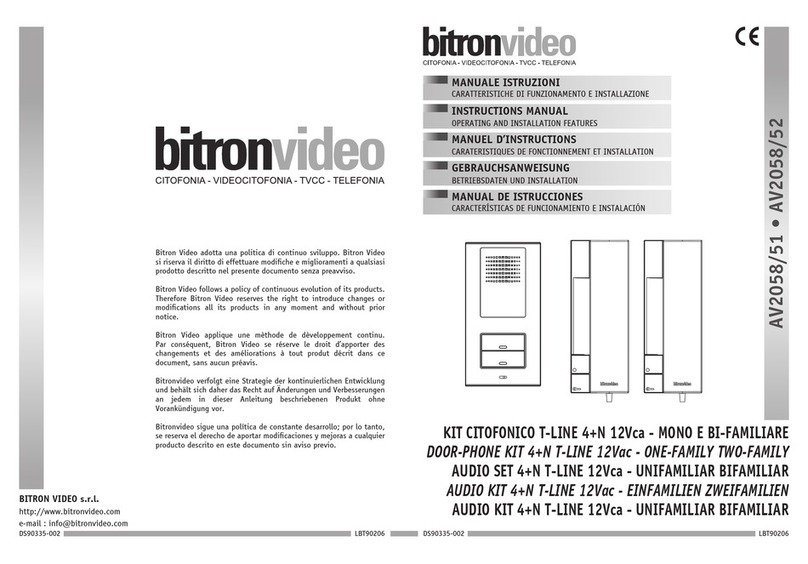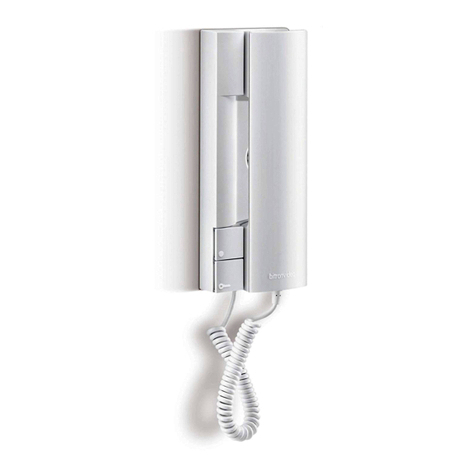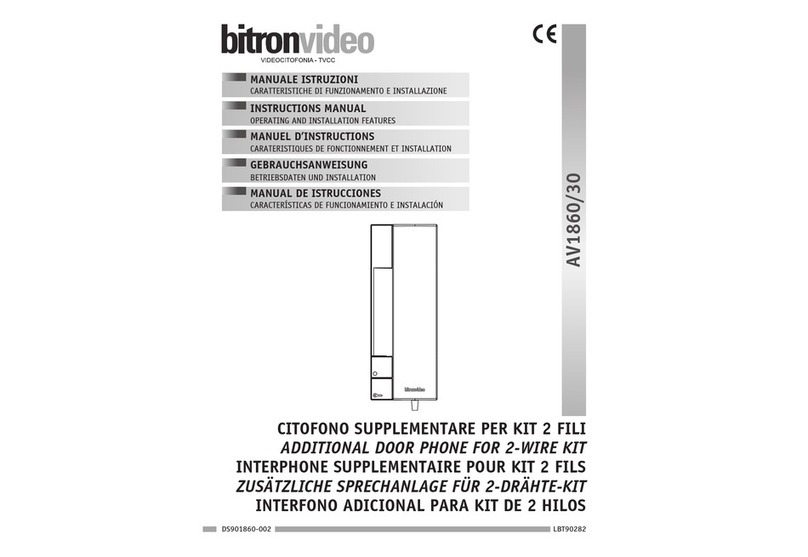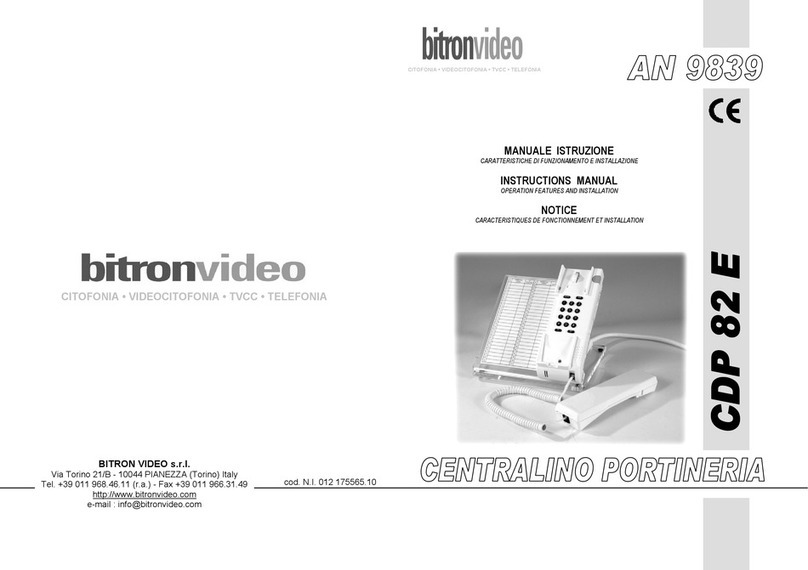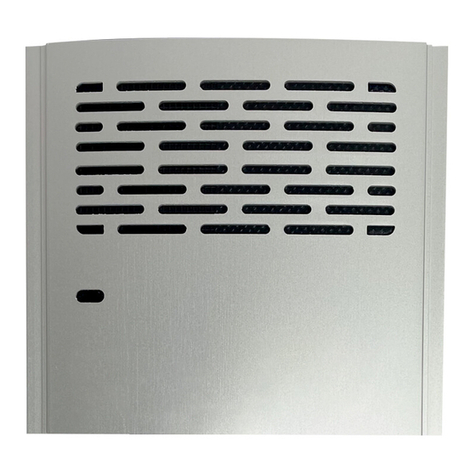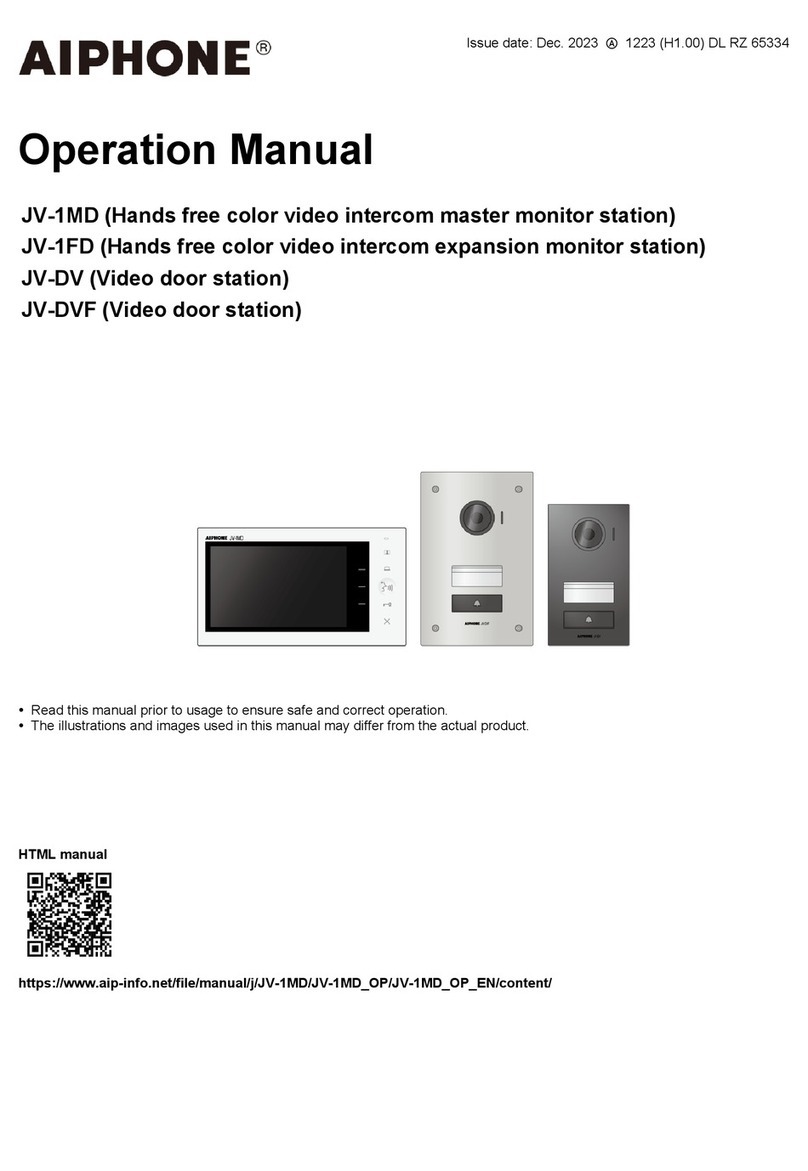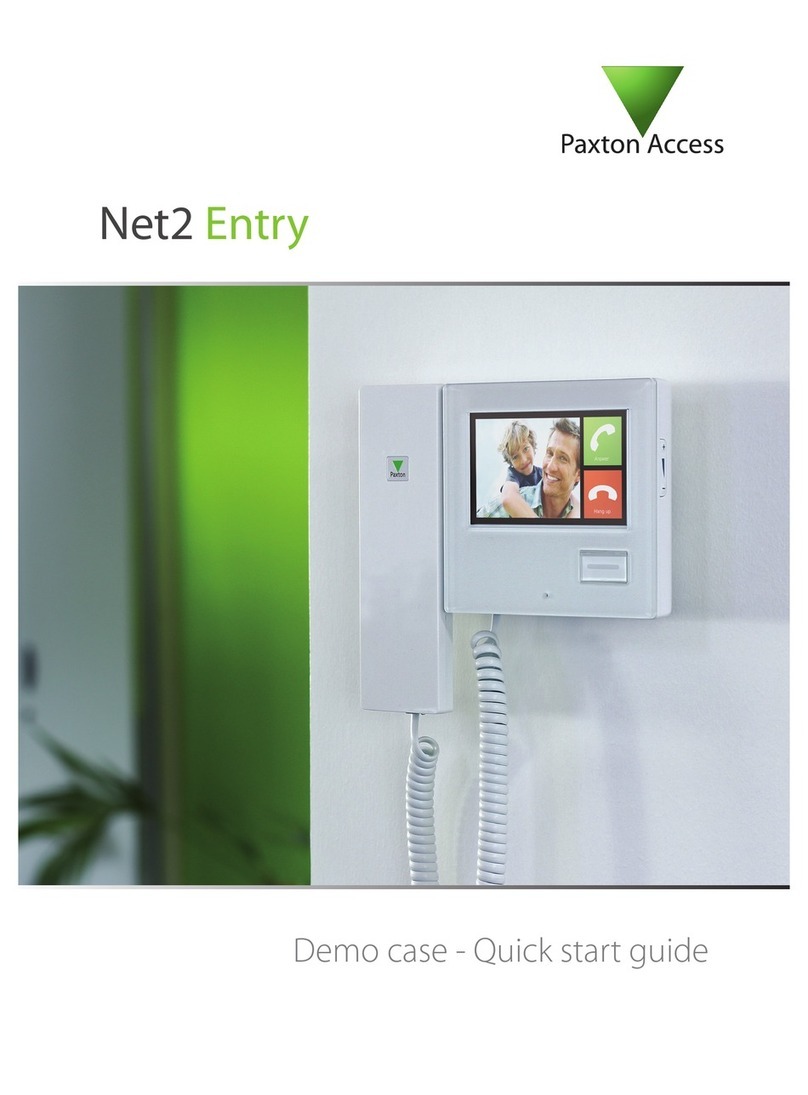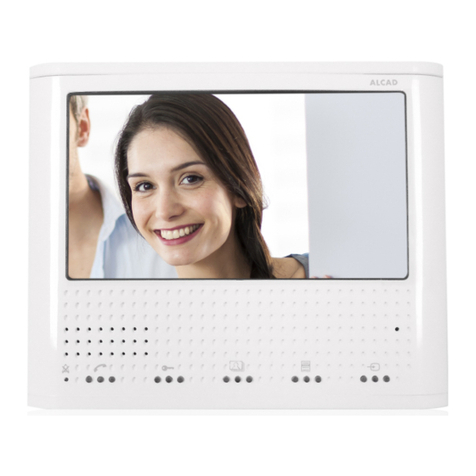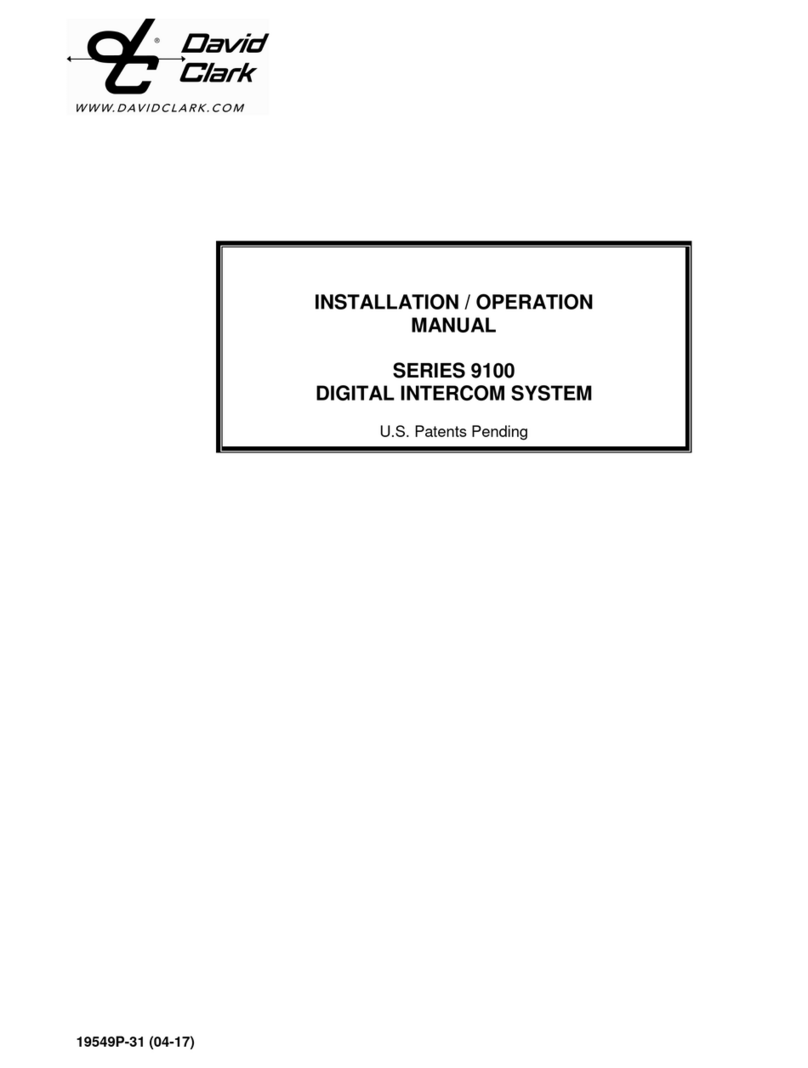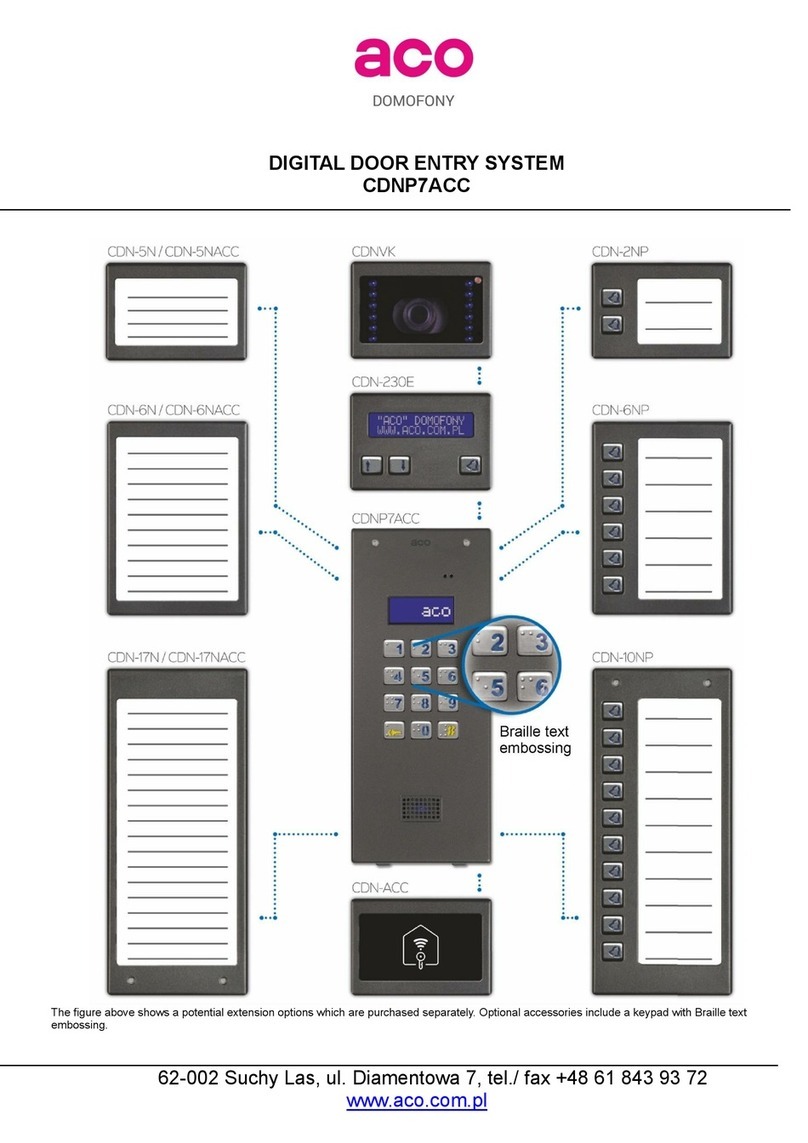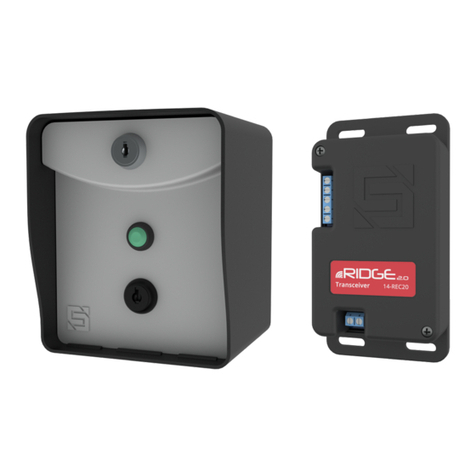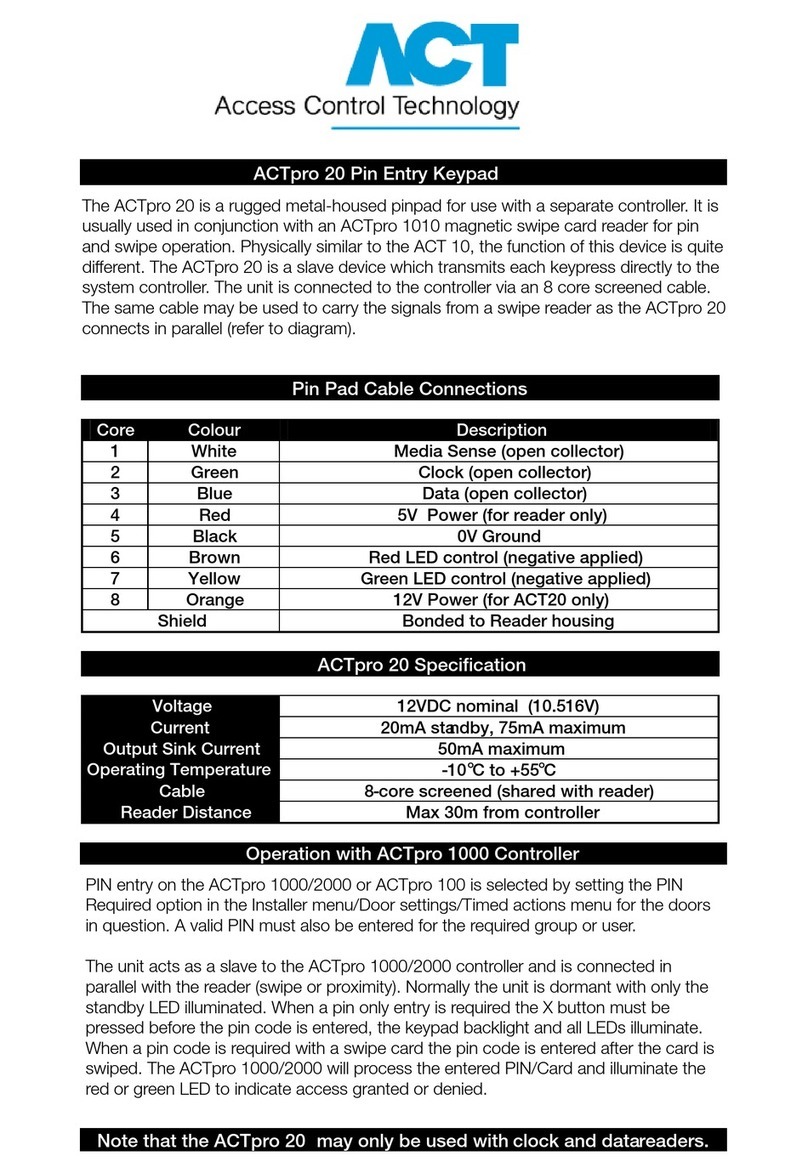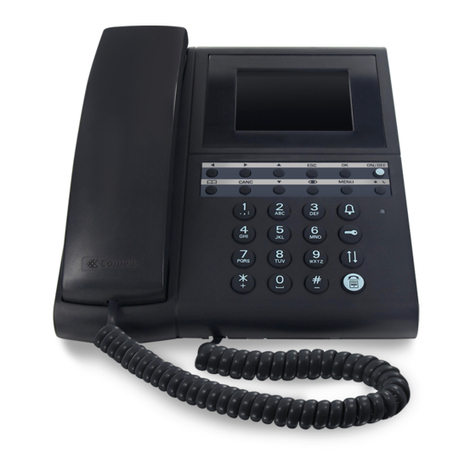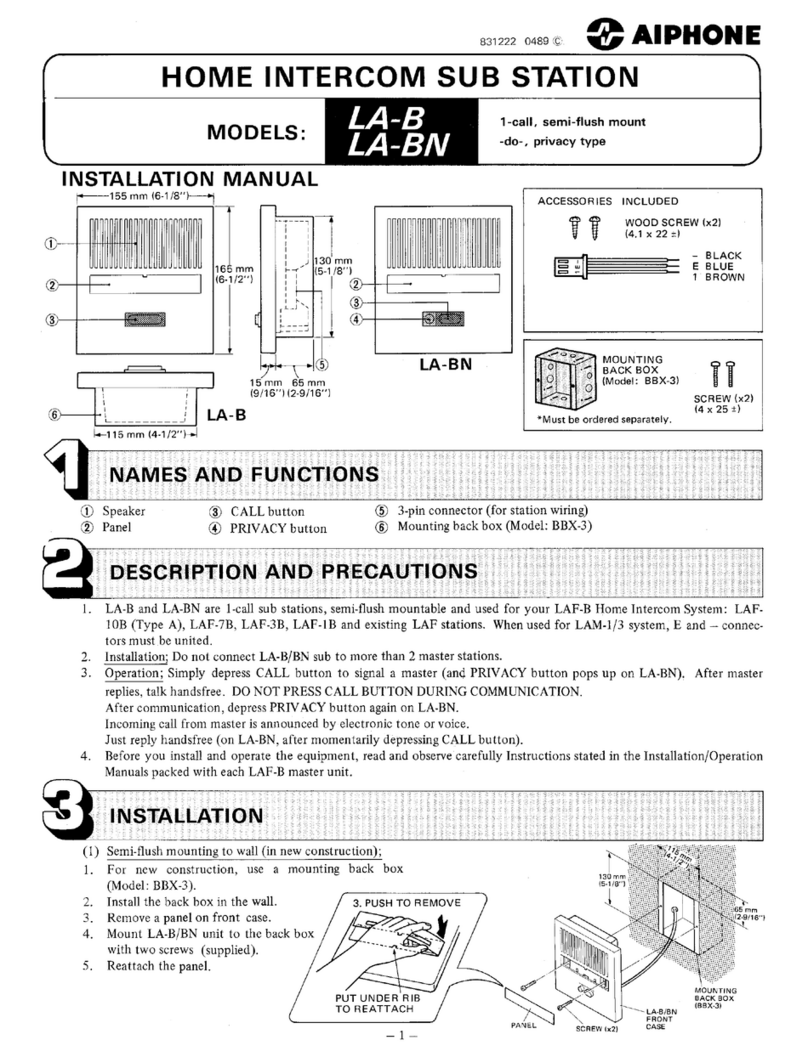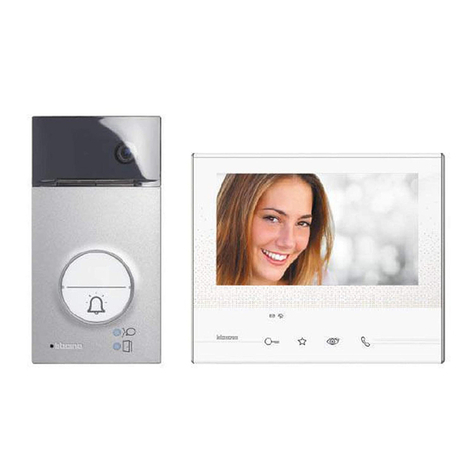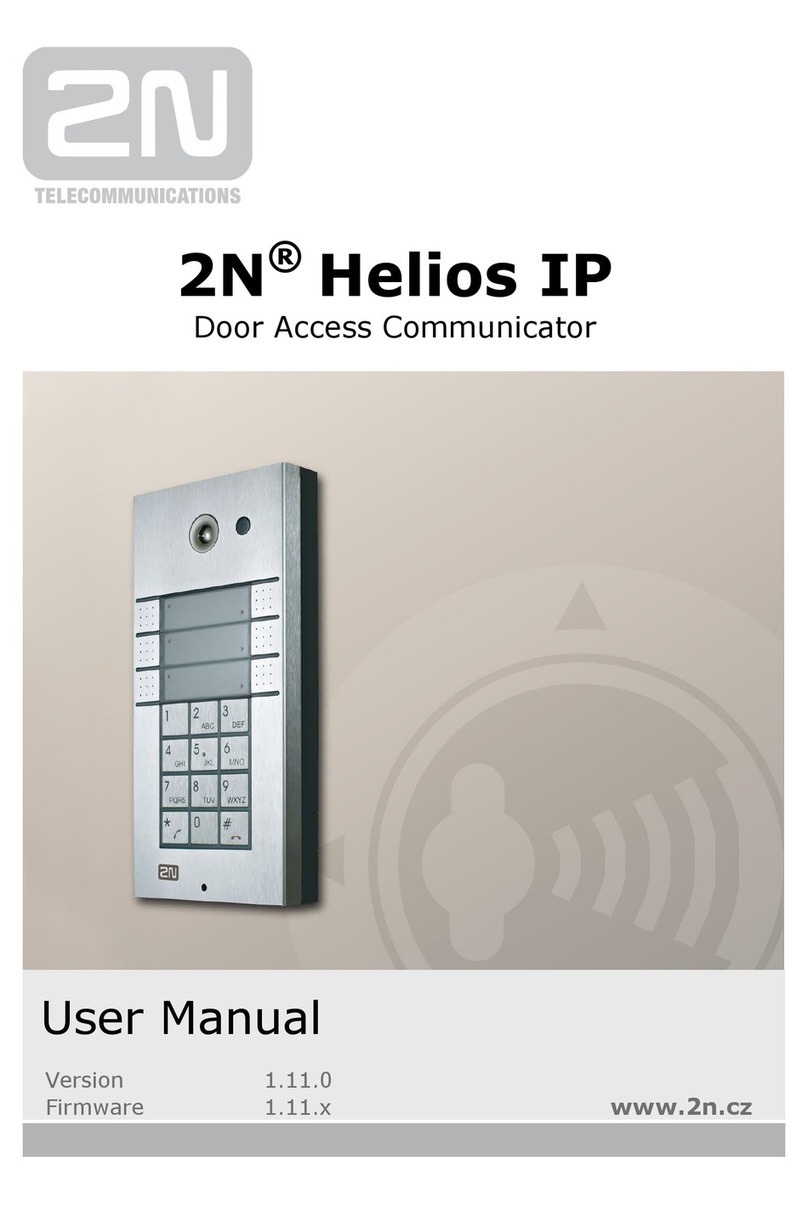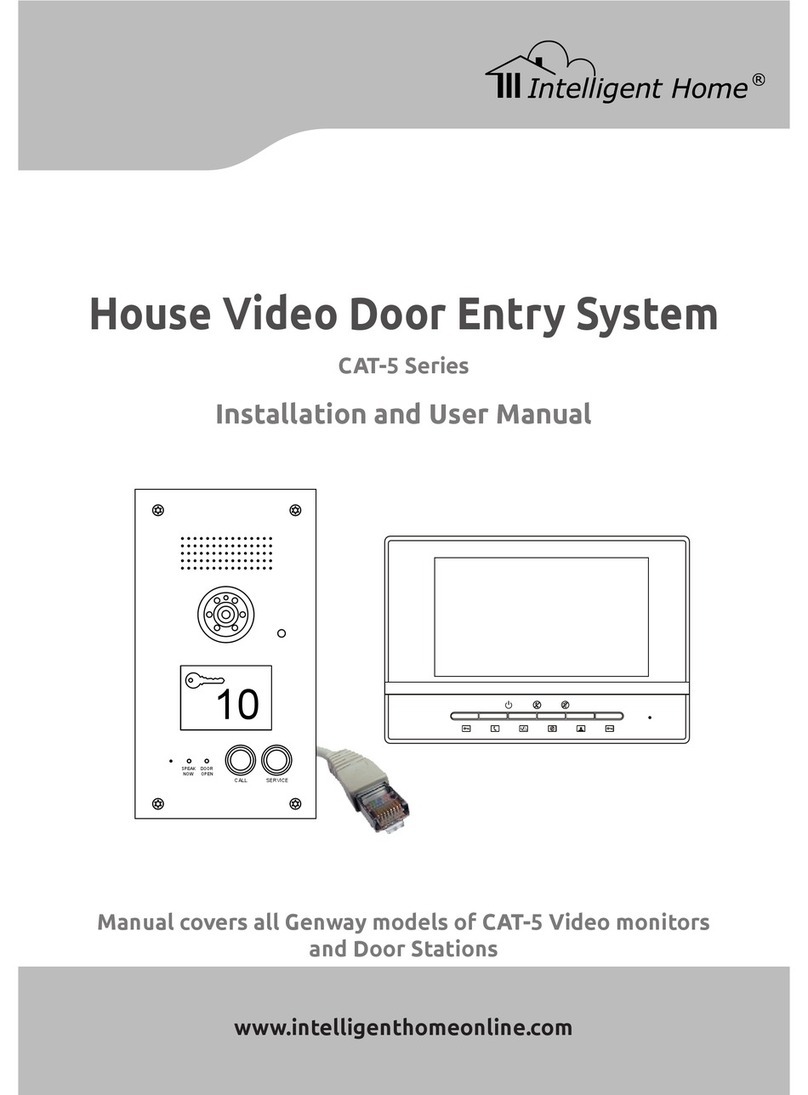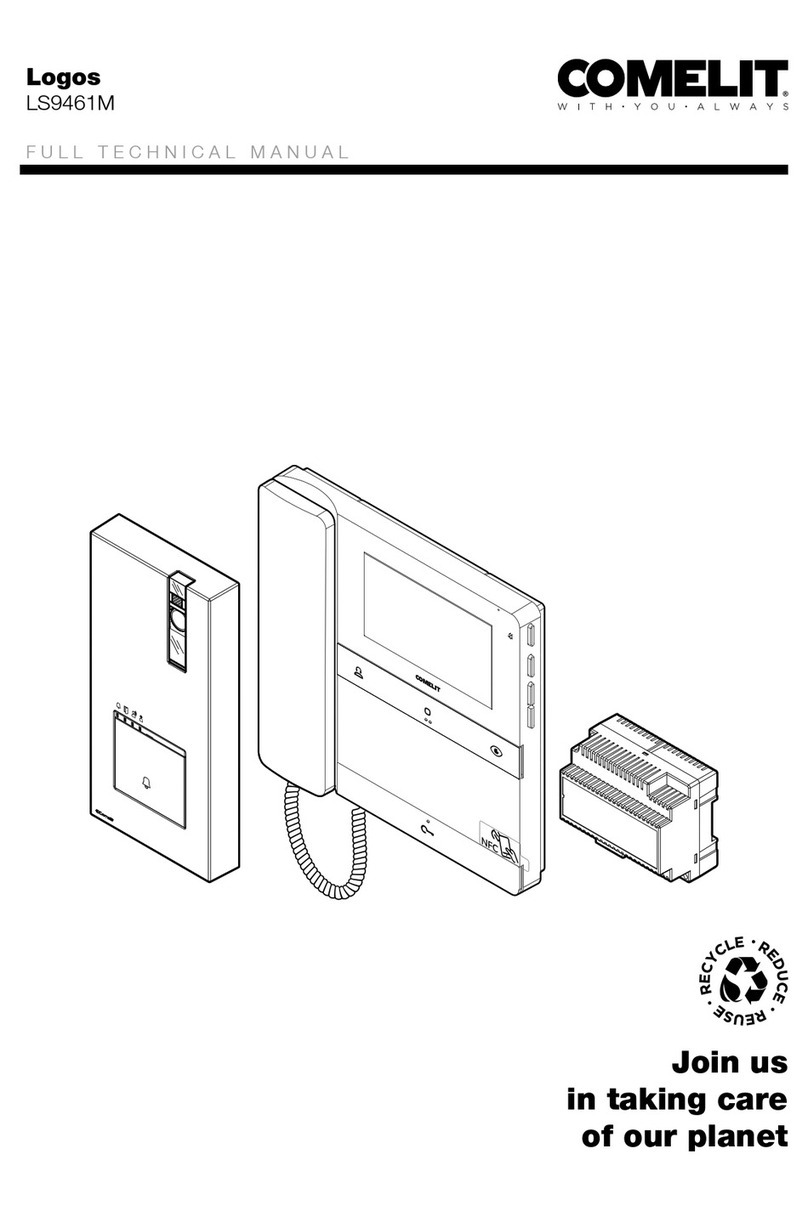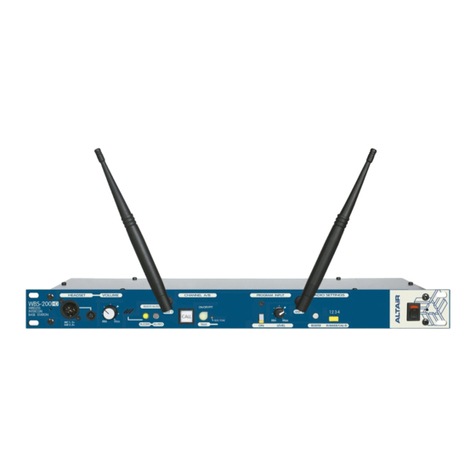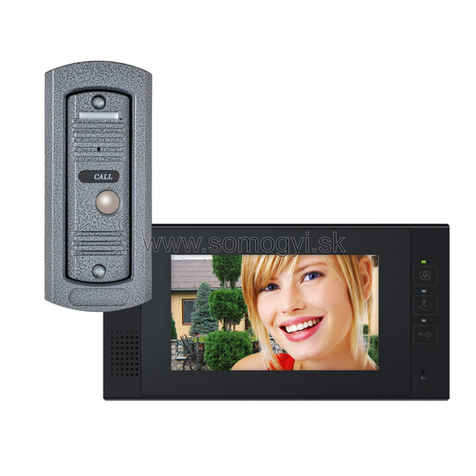Bitron Video AV1407/010 User manual

CITOFONO UNIVERSALE T-LINE
T-LINE UNIVERSAL DOOR PHONE
COMBINÉ UNIVERSEL T-LINE
INTERFÓNO UNIVERSAL T-LINE
MANUEL D’INSTRUCTIONS
CARATERISTIQUES DE FONCTIONNEMENT ET INSTALLATION
INSTRUCTIONS MANUAL
OPERATING AND INSTALLATION FEATURES
MANUALE ISTRUZIONI
CARATTERISTICHE DI FUNZIONAMENTO E INSTALLAZIONE
MANUAL DE ISTRUCCIONES
CARACTERÍSTICAS DE FUNCIONAMIENTO E INSTALACIÓN
AV1407/010
LBT90214DS90330-004B

2DS90330-004B DS90330-004B 3
CARATTERISTICHE
Le principali caratteristiche del citofono universale AV1407/010 sono le seguenti:
1. installazione in impianti 4+n (5 fili) e in impianti 1+n (2 fili) con qualsiasi modello di pulsantiera
2. possibilità di avere chiamata tradizionale su ronzatore o chiamata elettronica sull’altoparlante del
microtelefono
3. regolazione o esclusione di chiamata elettronica per mezzo di un commutatore a slitta a tre posizioni:
- volume massimo;
- volume minimo;
- esclusione di chiamata (segnalata mediante la fuoriuscita di una bandierina di segnalazione rossa dal
corpo del citofono).
4. possibilità di regolare il volume della fonia entrante (altoparlante del microtelefono)
5. possibilità di regolare il volume della fonia uscente (microfono del microtelefono)
Di fabbrica il citofono è configurato per fonia 4+n e chiamata su ronzatore.
DESCRIZIONE DEI MORSETTI
Collegamenti della morsettiera in funzione del tipo di impianto
2 fili (1+n) 5 fili (4+n)
APP Non connesso APP Chiamata a ronzatore o elettronica
1 Collegamento di massa dell’impianto 1 Fonia entrante (altoparlante)
2 Fonia/chiamata 2 Fonia uscente (microfono)
6 Non connesso 6 Massa impianto
OP Collegare al morsetto 1 del citofono OP Da collegare al morsetto 6 del citofono
OP Collegare al morsetto 2 del citofono OP Apriporta
Au Contatto ausiliario libero Au Contatto ausiliario libero
Au Contatto ausiliario libero Au Contatto ausiliario libero
INSTALLAZIONE
Procedura di montaggio su muro:
1,48 ÷ 1,52 m
IMPIANTI 4+N
Per impianti 4+n (5 fili) settare i jumper JP1÷JP5 tutti nella posizione “5”, come mostrato nella foto
(configurazione standard):
MIK
SPK
In caso di fonia tradizionale, lasciare i trimmer MIK e SPK come mostrato nella foto.
In caso di fonia elettronica, ruotare il trimmer SPK tutto in senso orario.
IMPIANTI 1+N
Lasciare il jumper JPC nella posizione “+”
Per impianti 1+n (2 fili) settare i jumper JP1÷JP5 tutti nella posizione “2”, come mostrato nella foto:
MIK
SPK
Ruotare il trimmer SPK tutto in senso orario.
Ruotare il trimmer MIK a circa metà corsa.
CHIAMATA SU RONZATORE
Posizionare il jumper JPA nella posizione “R”.
JPA
•
•
ITALIANO

2DS90330-004B DS90330-004B 3
CARATTERISTICHE
Le principali caratteristiche del citofono universale AV1407/010 sono le seguenti:
1. installazione in impianti 4+n (5 fili) e in impianti 1+n (2 fili) con qualsiasi modello di pulsantiera
2. possibilità di avere chiamata tradizionale su ronzatore o chiamata elettronica sull’altoparlante del
microtelefono
3. regolazione o esclusione di chiamata elettronica per mezzo di un commutatore a slitta a tre posizioni:
- volume massimo;
- volume minimo;
- esclusione di chiamata (segnalata mediante la fuoriuscita di una bandierina di segnalazione rossa dal
corpo del citofono).
4. possibilità di regolare il volume della fonia entrante (altoparlante del microtelefono)
5. possibilità di regolare il volume della fonia uscente (microfono del microtelefono)
Di fabbrica il citofono è configurato per fonia 4+n e chiamata su ronzatore.
DESCRIZIONE DEI MORSETTI
Collegamenti della morsettiera in funzione del tipo di impianto
2 fili (1+n) 5 fili (4+n)
APP Non connesso APP Chiamata a ronzatore o elettronica
1 Collegamento di massa dell’impianto 1 Fonia entrante (altoparlante)
2 Fonia/chiamata 2 Fonia uscente (microfono)
6 Non connesso 6 Massa impianto
OP Collegare al morsetto 1 del citofono OP Da collegare al morsetto 6 del citofono
OP Collegare al morsetto 2 del citofono OP Apriporta
Au Contatto ausiliario libero Au Contatto ausiliario libero
Au Contatto ausiliario libero Au Contatto ausiliario libero
INSTALLAZIONE
Procedura di montaggio su muro:
1,48 ÷ 1,52 m
IMPIANTI 4+N
Per impianti 4+n (5 fili) settare i jumper JP1÷JP5 tutti nella posizione “5”, come mostrato nella foto
(configurazione standard):
MIK
SPK
In caso di fonia tradizionale, lasciare i trimmer MIK e SPK come mostrato nella foto.
In caso di fonia elettronica, ruotare il trimmer SPK tutto in senso orario.
IMPIANTI 1+N
Lasciare il jumper JPC nella posizione “+”
Per impianti 1+n (2 fili) settare i jumper JP1÷JP5 tutti nella posizione “2”, come mostrato nella foto:
MIK
SPK
Ruotare il trimmer SPK tutto in senso orario.
Ruotare il trimmer MIK a circa metà corsa.
CHIAMATA SU RONZATORE
Posizionare il jumper JPA nella posizione “R”.
JPA
•
•
ITALIANO

4DS90330-004B DS90330-004B 5
CHIAMATA ELETTRONICA SU ALTOPARLANTE DEL MICROTELEFONO
Posizionare il jumper JA nella posizione “E”.
JPA
COLLEGAMENTO
IMPIANTI 4+N
chiamata
fonia entrante (altoparlante)
fonia uscente (microfono)
massa
apriporta
IMPIANTI 1+N
massa
fonia / chiamata
•ENGLISH
CHARACTERISTICS
The main characteristics of AV1407/010 universal door phone are the following:
1. installation in 4+n (5 wires) systems and in 1+n (2 wires) systems with any kind of push button panel.
2. possibility to have traditional call on buzzer or electronic call on handset loudspeaker
3. electronic call adjustment or disabling by a slide switch with three positions.
- Maximum volume;
- Minimum volume;
- call disabling (this is signalled by a little red flag, that comes out of the door phone body)
4. possibility to adjust the incoming speech signal volume (handset loudspeaker)
5. possibility to adjust the outcoming speech signal volume (handset loudspeaker)
By default the door phone is configured for 4+n signals and for call on buzzer.
.
TERMINAL PINS DESCRIPTION
Terminal strip connections according to the system wiring
2 wires (1+n) 5 wires (4+n)
APP Not connected APP Call tone by buzzer or electronic
1 System ground 1 Incoming speech signal (loudspeaker)
2 Speech signal/call tone 2 Outgoing speech signal (microphone)
6 Not connected 6 System ground
OP Connect to door phone terminal pin 1 OP To be connected to the door phone
terminal pin 6
OP Connect to door phone terminal pin 2 OP Door opener
Au Free auxiliary contact Au Free auxiliary contact
Au Free auxiliary contact Au Free auxiliary contact
INSTALLATION
Wall mounting procedure:
1,48 ÷ 1,52 m

4DS90330-004B DS90330-004B 5
CHIAMATA ELETTRONICA SU ALTOPARLANTE DEL MICROTELEFONO
Posizionare il jumper JA nella posizione “E”.
JPA
COLLEGAMENTO
IMPIANTI 4+N
chiamata
fonia entrante (altoparlante)
fonia uscente (microfono)
massa
apriporta
IMPIANTI 1+N
massa
fonia / chiamata
•ENGLISH
CHARACTERISTICS
The main characteristics of AV1407/010 universal door phone are the following:
1. installation in 4+n (5 wires) systems and in 1+n (2 wires) systems with any kind of push button panel.
2. possibility to have traditional call on buzzer or electronic call on handset loudspeaker
3. electronic call adjustment or disabling by a slide switch with three positions.
- Maximum volume;
- Minimum volume;
- call disabling (this is signalled by a little red flag, that comes out of the door phone body)
4. possibility to adjust the incoming speech signal volume (handset loudspeaker)
5. possibility to adjust the outcoming speech signal volume (handset loudspeaker)
By default the door phone is configured for 4+n signals and for call on buzzer.
.
TERMINAL PINS DESCRIPTION
Terminal strip connections according to the system wiring
2 wires (1+n) 5 wires (4+n)
APP Not connected APP Call tone by buzzer or electronic
1 System ground 1 Incoming speech signal (loudspeaker)
2 Speech signal/call tone 2 Outgoing speech signal (microphone)
6 Not connected 6 System ground
OP Connect to door phone terminal pin 1 OP To be connected to the door phone
terminal pin 6
OP Connect to door phone terminal pin 2 OP Door opener
Au Free auxiliary contact Au Free auxiliary contact
Au Free auxiliary contact Au Free auxiliary contact
INSTALLATION
Wall mounting procedure:
1,48 ÷ 1,52 m

6DS90330-004B DS90330-004B 7
4+N SYSTEMS
For 4+n (5 wires) systems, put all the jumpers JP1÷JP5 in position “5”, as shown in the photo (standard
configuration):
MIK
SPK
In case of traditional speech signal, set the trimmers MIK and SPK as shown in the photo.
In case of electronic speech signal, rotate all the trimmer SPK clockwise.
1+N SYSTEMS
Leave the jumper JPC in “+” position.
For 1+n (2 wires) systems, put all the jumpers JP1÷JP5 in position “2”, as shown in the photo:
MIK
SPK
Rotate all the trimmer SPK clockwise.
Rotate the trimmer MIK at about central stroke position.
CALL BY BUZZER
Put the jumper JPA in position “R”.
JPA
•
ELECTRONIC CALL BY HANDSET LOUDSPEAKER
Put the jumper JPA in position “E”.
JPA
CONNECTIONS
4+N SYSTEMS
call
incoming speech signal (loudspeaker)
outgoing speech signal (microphone)
system ground
door opener
1+N SYSTEMS
system ground
speech signal / call tone
•

6DS90330-004B DS90330-004B 7
4+N SYSTEMS
For 4+n (5 wires) systems, put all the jumpers JP1÷JP5 in position “5”, as shown in the photo (standard
configuration):
MIK
SPK
In case of traditional speech signal, set the trimmers MIK and SPK as shown in the photo.
In case of electronic speech signal, rotate all the trimmer SPK clockwise.
1+N SYSTEMS
Leave the jumper JPC in “+” position.
For 1+n (2 wires) systems, put all the jumpers JP1÷JP5 in position “2”, as shown in the photo:
MIK
SPK
Rotate all the trimmer SPK clockwise.
Rotate the trimmer MIK at about central stroke position.
CALL BY BUZZER
Put the jumper JPA in position “R”.
JPA
•
ELECTRONIC CALL BY HANDSET LOUDSPEAKER
Put the jumper JPA in position “E”.
JPA
CONNECTIONS
4+N SYSTEMS
call
incoming speech signal (loudspeaker)
outgoing speech signal (microphone)
system ground
door opener
1+N SYSTEMS
system ground
speech signal / call tone
•

8DS90330-004B DS90330-004B 9
FRANÇAIS
CARACTÉRISTIQUES
Les caractéristiques principales de l’interphone universel AV1407/010 sont les suivantes:
1. installation dans les systèmes 4+n (5 fils) et dans les systèmes 1+n (2 fils) avec toute plaque de rue
2. possibilité d’avoir un appel traditionnel avec ronfleur ou un appel électronique avec le haut-parleur du
combiné
3. réglage ou exclusion d’appel électronique par le biais d’un interrupteur à coulisse avec trois positions:
- volume maximum;
- volume minimum;
- exclusion d’appel (signalée par la sortie d’un petit drapeau rouge de signalisation du combiné).
4. possibilité de régler le volume de la phonie montante (haut-parleur du combiné)
5. possibilité de régler le volume de la phonie descendante (microphone du combiné)
En usine le combiné est configuré pour une installation 4+n et appel avec ronfleur.
DESCRIPTION DES BORNES
Branchements du bornier en fonction du type de système
2 fils (1+n) 5 fils (4+n)
APP Non connecté APP Appel avec ronfleur ou électronique
1 Masse du système 1 Phonie montante (haut-parleur)
2 Phonie/appel 2 Phonie descendante (microphone)
6 Non connecté 6 Masse du système
OP Connecter à la borne 1 du combiné OP A connecter avec la borne 6 du combiné
OP Connecter à la borne 2 du combiné OP Ouvre-porte
Au Contact auxiliaire libre Au Contact auxiliaire libre
Au Contact auxiliaire libre Au Contact auxiliaire libre
INSTALLATION
Procédure d’installation murale:
1,48 ÷ 1,52 m
SYSTÈMES 4+N
Pour les systèmes 4+n (5 fils), configurer tous les jumpers JP1 a JP5 en position “5”, comme illustré sur la
photo ci-dessous (configuration standard).
MIK
SPK
Dans le cas de phonie traditionnelle (capsule charbon), laisser les trimmers MIK et SPK comme comme illustré
sur la photo. Dans le cas de phonie électronique (micro-électret), tourner le trimmer SPK à fond dans le sens
des aiguilles d’une montre.
SYSTÈMES 1+N
Laisser le jumper JPC en position “+”.
Pour les systèmes 1+n (2 fils) configurer tous les jumpers JP1 a JP5 en position “2”, comme illustré sur la
photo ci-dessous:
MIK
SPK
Tourner le trimmer SPK à fond dans le sens des aiguilles d’une montre
Tourner le trimmer MIK environ à moitié course.
APPEL AVEC RONFLEUR
Positionner le jumper JPA en position “R”.
JPA
•

8DS90330-004B DS90330-004B 9
FRANÇAIS
CARACTÉRISTIQUES
Les caractéristiques principales de l’interphone universel AV1407/010 sont les suivantes:
1. installation dans les systèmes 4+n (5 fils) et dans les systèmes 1+n (2 fils) avec toute plaque de rue
2. possibilité d’avoir un appel traditionnel avec ronfleur ou un appel électronique avec le haut-parleur du
combiné
3. réglage ou exclusion d’appel électronique par le biais d’un interrupteur à coulisse avec trois positions:
- volume maximum;
- volume minimum;
- exclusion d’appel (signalée par la sortie d’un petit drapeau rouge de signalisation du combiné).
4. possibilité de régler le volume de la phonie montante (haut-parleur du combiné)
5. possibilité de régler le volume de la phonie descendante (microphone du combiné)
En usine le combiné est configuré pour une installation 4+n et appel avec ronfleur.
DESCRIPTION DES BORNES
Branchements du bornier en fonction du type de système
2 fils (1+n) 5 fils (4+n)
APP Non connecté APP Appel avec ronfleur ou électronique
1 Masse du système 1 Phonie montante (haut-parleur)
2 Phonie/appel 2 Phonie descendante (microphone)
6 Non connecté 6 Masse du système
OP Connecter à la borne 1 du combiné OP A connecter avec la borne 6 du combiné
OP Connecter à la borne 2 du combiné OP Ouvre-porte
Au Contact auxiliaire libre Au Contact auxiliaire libre
Au Contact auxiliaire libre Au Contact auxiliaire libre
INSTALLATION
Procédure d’installation murale:
1,48 ÷ 1,52 m
SYSTÈMES 4+N
Pour les systèmes 4+n (5 fils), configurer tous les jumpers JP1 a JP5 en position “5”, comme illustré sur la
photo ci-dessous (configuration standard).
MIK
SPK
Dans le cas de phonie traditionnelle (capsule charbon), laisser les trimmers MIK et SPK comme comme illustré
sur la photo. Dans le cas de phonie électronique (micro-électret), tourner le trimmer SPK à fond dans le sens
des aiguilles d’une montre.
SYSTÈMES 1+N
Laisser le jumper JPC en position “+”.
Pour les systèmes 1+n (2 fils) configurer tous les jumpers JP1 a JP5 en position “2”, comme illustré sur la
photo ci-dessous:
MIK
SPK
Tourner le trimmer SPK à fond dans le sens des aiguilles d’une montre
Tourner le trimmer MIK environ à moitié course.
APPEL AVEC RONFLEUR
Positionner le jumper JPA en position “R”.
JPA
•

10 DS90330-004B DS90330-004B 11
CARACTERÍSTICAS
Las principales características del interfóno universal AV1407/010 son las siguientes:
1. instalación en sistemas 4+n (5 hilos) y en sistemas 1+n (2 hilos) con todas le caja de pulsadora
2. posibilidad de recibir llamada tradicional en timbre trepidante o llamada electrónica en el altavoz del
microteléfono
3. regulación o exclusión de llamada electrónica por medio de un conmutador con corredera con tres
posiciones:
- volumen máximo;
- volumen mínimo;
- exclusión de llamada (indicada mediante el escape de un banderín de aviso rojo de adentro del
interfóno).
4. posibilidad de regular el volumen de la fonía en entrada (altavoz del microteléfono)
5. posibilidad de regular el volumen de la fonía en salida (altavoz del microteléfono)
De producción el interfóno esta actvado como función 4+n y llamada en timbre trepidante.
DESCRIPCIÓN DE LOS BORNES
Conexión de la caja de bornes según el tipo de sistema
2 hilos (1+n) 5 hilos (4+n)
APP No conectado APP Llamada hacía timbre trepidante o
electrónica
1 Conexión de masa del sistema 1 Fonía en entrada (altavoz)
2 Fonía/llamada 2 Fonía en salida (micrófono)
6 No conectado 6 Masa sistema
OP Conectar en el borne 1 del interfóno OP Conectar en el borne 6 del interfóno
OP Conectar en el borne 2 del interfóno OP Apertura de puerta
Au Contacto auxiliar libre Au Contacto auxiliar libre
Au Contacto auxiliar libre Au Contacto auxiliar libre
INSTALACIÓN
Procedimiento de montaje en la pared:
1,48 ÷ 1,52 m
ESPAÑOL
APPEL ÉLECTRONIQUE SUR LE HAUT-PARLEUR DU COMBINÉ
Positionner le jumper JPA en position “E”.
JPA
BRANCHEMENTS
SYSTÉMES 4+N
appel
phonie montante (haut-parleur)
phonie descendante (microphone)
masse
ouvre-porte
SYSTÉMES 1+N
masse
phonie / appel
•

10 DS90330-004B DS90330-004B 11
CARACTERÍSTICAS
Las principales características del interfóno universal AV1407/010 son las siguientes:
1. instalación en sistemas 4+n (5 hilos) y en sistemas 1+n (2 hilos) con todas le caja de pulsadora
2. posibilidad de recibir llamada tradicional en timbre trepidante o llamada electrónica en el altavoz del
microteléfono
3. regulación o exclusión de llamada electrónica por medio de un conmutador con corredera con tres
posiciones:
- volumen máximo;
- volumen mínimo;
- exclusión de llamada (indicada mediante el escape de un banderín de aviso rojo de adentro del
interfóno).
4. posibilidad de regular el volumen de la fonía en entrada (altavoz del microteléfono)
5. posibilidad de regular el volumen de la fonía en salida (altavoz del microteléfono)
De producción el interfóno esta actvado como función 4+n y llamada en timbre trepidante.
DESCRIPCIÓN DE LOS BORNES
Conexión de la caja de bornes según el tipo de sistema
2 hilos (1+n) 5 hilos (4+n)
APP No conectado APP Llamada hacía timbre trepidante o
electrónica
1 Conexión de masa del sistema 1 Fonía en entrada (altavoz)
2 Fonía/llamada 2 Fonía en salida (micrófono)
6 No conectado 6 Masa sistema
OP Conectar en el borne 1 del interfóno OP Conectar en el borne 6 del interfóno
OP Conectar en el borne 2 del interfóno OP Apertura de puerta
Au Contacto auxiliar libre Au Contacto auxiliar libre
Au Contacto auxiliar libre Au Contacto auxiliar libre
INSTALACIÓN
Procedimiento de montaje en la pared:
1,48 ÷ 1,52 m
ESPAÑOL
APPEL ÉLECTRONIQUE SUR LE HAUT-PARLEUR DU COMBINÉ
Positionner le jumper JPA en position “E”.
JPA
BRANCHEMENTS
SYSTÉMES 4+N
appel
phonie montante (haut-parleur)
phonie descendante (microphone)
masse
ouvre-porte
SYSTÉMES 1+N
masse
phonie / appel
•

12 DS90330-004B DS90330-004B 13
SISTEMAS 4+N
Para sistemas 4+n (5 hilos) posicionar los puentes de conexión JP1÷JP5 todos en la posición “5”, como
indicado en la foto (configuración estándar):
MIK
SPK
En el caso de fonía tradicional, dejar el trimmer MIK y SPK como indicado en la foto.
En el caso de fonía electrónica, girar el trimmer SPK todo en sentido orario.
SISTEMAS 1+N
Dejer el puente JPC en la posición “+”.
Para sistemas 1+n (2 hilos) posicionar los puentes de conexión JP1÷JP5 todos en la posición “2”, como
indicado en la foto:
MIK
SPK
Girar el trimmer SPK todo en sentido orario.
Girar el trimmer MIK hasta casi mitad recorrido.
LLAMADA HACIA TIMBRE TREPIDANTE
Posicionar el puente de conexión JPA en la posición “R”.
JPA
•
LLAMADA ELECTRÓNICA HACIA ALTAVOZ DEL MICROTELÉFONO
Posicionar el puente de conexión JPA en la posición “E”.
JPA
CONNEXION
SISTEMAS 4+N
llamada
fonía en entrada (altavoz)
fonía en salida (micrófono)
masa
apertura puerta
SISTEMAS 1+N
masa
fonía / llamada
•

12 DS90330-004B DS90330-004B 13
SISTEMAS 4+N
Para sistemas 4+n (5 hilos) posicionar los puentes de conexión JP1÷JP5 todos en la posición “5”, como
indicado en la foto (configuración estándar):
MIK
SPK
En el caso de fonía tradicional, dejar el trimmer MIK y SPK como indicado en la foto.
En el caso de fonía electrónica, girar el trimmer SPK todo en sentido orario.
SISTEMAS 1+N
Dejer el puente JPC en la posición “+”.
Para sistemas 1+n (2 hilos) posicionar los puentes de conexión JP1÷JP5 todos en la posición “2”, como
indicado en la foto:
MIK
SPK
Girar el trimmer SPK todo en sentido orario.
Girar el trimmer MIK hasta casi mitad recorrido.
LLAMADA HACIA TIMBRE TREPIDANTE
Posicionar el puente de conexión JPA en la posición “R”.
JPA
•
LLAMADA ELECTRÓNICA HACIA ALTAVOZ DEL MICROTELÉFONO
Posicionar el puente de conexión JPA en la posición “E”.
JPA
CONNEXION
SISTEMAS 4+N
llamada
fonía en entrada (altavoz)
fonía en salida (micrófono)
masa
apertura puerta
SISTEMAS 1+N
masa
fonía / llamada
•

14 DS90330-004B DS90330-004B 15
IMPIANTO CITOFONICO (SISTEMA “1 + n”), CON 1 POSTO ESTERNO, CHIAMATA ELETTRONICA
“1 + n” DOOR PHONE SYSTEM, WITH ELECTRONIC CALL FROM 1 VISITOR PANEL
SISTEME DE PORTIER “1+n” AVEC UNE PLAQUE DE RUE, APPEL ELECTRONIQUE
SISTEMA INTERFONICO “1+n” CON 1 PLACA EXTERIOR, LLAMADA ELECTRONICA
179 233 81
All rights reserved - Diritti riservati a Norma di Legge
APP
1
2
Au
OP
6
Au
OP
AV 1407/010
APP
1
2
Au
OP
6
Au
OP
AV 1407/010
12
0
AN 1299
CD
CH
0
Ap
_
CP
P
CD 1-4
CD 5-8
P8
P7
P6
P5
P4
P3
P2
P1
L
L
AN 9524/L
AN6215/L
ap. ext.
APP
1
2
Au
OP
6
Au
OP
AV 1407/010
Colonna
Riser
Colonne
Columna
RETE
MAINS
SECTEUR
RED
Serratura
Lock
Serrure
Cerradura
NOTE:
Utilizzando AV 1407/010:
- spostare il jumper JPA nella posizione “E”
- spostare i jumper JP1÷JP5 nella posizione “2”.
- Max. estensione complessiva dell’impianto = 100 m
NOTES:
When using AV 1407/010:
- move jumper JPA into position “E”
- move jumpers JP1÷JP5 into position “2”.
- Maximum total distance 100 m
NOTE:
Au cas ou l’utilise AV1407/010:
- positionner le jumper JPA en position “E”
- positionner les jumpers JP1÷JP5 en position “2”.
- Max. extension total de l’installation = 100m
NOTES:
Utilizando AV1407/010:
- posicionar el puente de connexión JPA en la posicion “E”
- posicionar los puentes de connexión JP1÷JP5 en la
posicion “2”.
- Max. extención global de la instalación = 100m
IMPIANTO CITOFONICO (SISTEMA “4 + n”), CON 1 POSTO ESTERNO, CHIAMATA ELETTRONICA
“4 + n” DOOR PHONE SYSTEM, WITH ELECTRONIC CALL FROM 1 VISITOR PANEL
SISTEME DE PORTIER “4+n” AVEC UNE PLAQUE DE RUE, APPEL ELECTRONIQUE
SISTEMA INTERFONICO “4+n” CON 1 PLACA EXTERIOR, LLAMADA ELECTRONICA
179 233 80
All rights reserved - Diritti riservati a Norma di Legge
Colonna
Riser
Colonne
Columna
RETE
MAINS
SECTEUR
RED
Serratura
Lock
Serrure
Cerradura
NOTE:
Utilizzando AV 1407/010:
- spostare i jumper JP1÷JP5 nella posizione “5”
NOTES:
When using AV 1407/010:
- move jumpers JP1÷JP5 into position “5”
NOTE:
Au cas ou l’utilise AV1407/010:
- positionner les jumpers JP1÷JP5 en position “5”
NOTES:
Si usado AV1407/010:
- posicionar los puentes de connexión JP1÷JP5
en la posicion “5”
CD 1-4
CD 5-8
P8
P7
P6
P5
P4
P3
P2
P1
L
L
1
-
0
+
P
~
2
C
AN 9516/L
AN6215/L
APP
1
2
Au
OP
6
Au
OP
AV 1407/010
ser1
ser2
APP
1
2
Au
OP
6
Au
OP
AV 1407/010
APP
1
2
Au
OP
6
Au
OP
AV 1407/010
21
0
230
+
_
_
C
_
AV 1142

14 DS90330-004B DS90330-004B 15
IMPIANTO CITOFONICO (SISTEMA “1 + n”), CON 1 POSTO ESTERNO, CHIAMATA ELETTRONICA
“1 + n” DOOR PHONE SYSTEM, WITH ELECTRONIC CALL FROM 1 VISITOR PANEL
SISTEME DE PORTIER “1+n” AVEC UNE PLAQUE DE RUE, APPEL ELECTRONIQUE
SISTEMA INTERFONICO “1+n” CON 1 PLACA EXTERIOR, LLAMADA ELECTRONICA
179 233 81
All rights reserved - Diritti riservati a Norma di Legge
APP
1
2
Au
OP
6
Au
OP
AV 1407/010
APP
1
2
Au
OP
6
Au
OP
AV 1407/010
12
0
AN 1299
CD
CH
0
Ap
_
CP
P
CD 1-4
CD 5-8
P8
P7
P6
P5
P4
P3
P2
P1
L
L
AN 9524/L
AN6215/L
ap. ext.
APP
1
2
Au
OP
6
Au
OP
AV 1407/010
Colonna
Riser
Colonne
Columna
RETE
MAINS
SECTEUR
RED
Serratura
Lock
Serrure
Cerradura
NOTE:
Utilizzando AV 1407/010:
- spostare il jumper JPA nella posizione “E”
- spostare i jumper JP1÷JP5 nella posizione “2”.
- Max. estensione complessiva dell’impianto = 100 m
NOTES:
When using AV 1407/010:
- move jumper JPA into position “E”
- move jumpers JP1÷JP5 into position “2”.
- Maximum total distance 100 m
NOTE:
Au cas ou l’utilise AV1407/010:
- positionner le jumper JPA en position “E”
- positionner les jumpers JP1÷JP5 en position “2”.
- Max. extension total de l’installation = 100m
NOTES:
Utilizando AV1407/010:
- posicionar el puente de connexión JPA en la posicion “E”
- posicionar los puentes de connexión JP1÷JP5 en la
posicion “2”.
- Max. extención global de la instalación = 100m
IMPIANTO CITOFONICO (SISTEMA “4 + n”), CON 1 POSTO ESTERNO, CHIAMATA ELETTRONICA
“4 + n” DOOR PHONE SYSTEM, WITH ELECTRONIC CALL FROM 1 VISITOR PANEL
SISTEME DE PORTIER “4+n” AVEC UNE PLAQUE DE RUE, APPEL ELECTRONIQUE
SISTEMA INTERFONICO “4+n” CON 1 PLACA EXTERIOR, LLAMADA ELECTRONICA
179 233 80
All rights reserved - Diritti riservati a Norma di Legge
Colonna
Riser
Colonne
Columna
RETE
MAINS
SECTEUR
RED
Serratura
Lock
Serrure
Cerradura
NOTE:
Utilizzando AV 1407/010:
- spostare i jumper JP1÷JP5 nella posizione “5”
NOTES:
When using AV 1407/010:
- move jumpers JP1÷JP5 into position “5”
NOTE:
Au cas ou l’utilise AV1407/010:
- positionner les jumpers JP1÷JP5 en position “5”
NOTES:
Si usado AV1407/010:
- posicionar los puentes de connexión JP1÷JP5
en la posicion “5”
CD 1-4
CD 5-8
P8
P7
P6
P5
P4
P3
P2
P1
L
L
1
-
0
+
P
~
2
C
AN 9516/L
AN6215/L
APP
1
2
Au
OP
6
Au
OP
AV 1407/010
ser1
ser2
APP
1
2
Au
OP
6
Au
OP
AV 1407/010
APP
1
2
Au
OP
6
Au
OP
AV 1407/010
21
0
230
+
_
_
C
_
AV 1142

16 DS90330-004B DS90330-004B 17
AV1407/010 OP / OP 2 6 1 APP ( E ) APP ( R )
Casa costruttrice
Manufacturer
Marque
Fabricante
Apertura porta
Door opener
Ouverture de
porte
Apertura de
puerta
Fonia uscente
Outgoing
speech signal
Phonie
descendante
Fonia en salida
Massa
Ground
Masse
Masa
Fonia entrante
Ingoing speech
signal
Phonie
montante
Fonia en
entrada
Chiamata
elettronica
Electronic call tone
Appel électronique
Llamada
electronica
Chiamata su buzzer
Call tone by buzzer
Appel ronfleur
Llamada en
zumbador
ACET 5 10 2 7 9
ACET-ANTENOPHONE 5 10 2 7 9
ACET-ANTENOPHONE 7 3 6 4 5
AIPHONE (poste CVK) 4 1 3 2 B
AMPER D A C B E
AMPLIVOX Z T 0 R 1
AMPLIVOX Z 8 0 T 1
AMPLIVOX 2 T 0 R 1
ATEA 2 4 3 1 5
AUTA TF92 10 3 4 7 12
AUTELCO P5 a 1 b 2
BELL SYSTEM
TELEPHO.
ZROT I
BITRON VIDEO 9 2 6 1 C7 11
BOGEN T 1 3 2 6
BPT 2 1 4 5 3
CENTRAMATIC 4 2 1 3 5
CEVAM 2 6 9 4 R
CITESA 1 4 C 3 B
CITOFONIX 3 1 2 4 5
CITOVOX 5 10 9 7 T
COFREL TERANEO LT T 2 3 1 6
COMELIT 5 3/6 4 2 1
ELBEX MIC LOW SPEC +
ELBOX 2 6 9 4 +
ELBOX 7 2 3/4/5 1 6
FARFISA 5 1 3 2 6
FERMAX 1 2 3 6 4
FERMAX
2044,20440,21100
1236 4
FERMAX GONDOLA 4 1 3 2 V/5
FERMAX REKTO TF-4 P A C B E
FRINGE 2 3 1 6 4
GAME P 2 3 1 Z
GIRO 2 3 1 6 4
GOLMAR X M A S N
GOLMAR C2 5 3 10 7
GOLMAR 11 5 3 4 12
GOLMAR T-2800 4 5 3 10 7
AV1407/010 OP / OP 2 6 1 APP ( E ) APP ( R )
Casa costruttrice
Manufacturer
Marque
Fabricante
Apertura porta
Door opener
Ouverture de
porte
Apertura de
puerta
Fonia uscente
Outgoing
speech signal
Phonie
descendante
Fonia en salida
Massa
Ground
Masse
Masa
Fonia entrante
Ingoing speech
signal
Phonie
montante
Fonia en
entrada
Chiamata
elettronica
Electronic call tone
Appel électronique
Llamada
electronica
Chiamata su buzzer
Call tone by buzzer
Appel ronfleur
Llamada en
zumbador
GOLMAR T-600 T 1 3 2 6
LT TERRANEO COFREL T1 1 3 2 6
OSTELVI 9 2 6 1 7
PORMAT 4 3 2/5 1 v
RIPOLLES 3 1 8 2 4
RITTO ELEGANT 40518 11 12 13 15 14
SAFNAT 4 1 2 3 v
SELTI 5 1 3 2 6
SIEDLE HTA 711-01 I 12 9/C 11 7
SPRINT “/” 1 3 2 6
STR NH200 1 M O T S
STR NH205 1 M O T S
TAGRA 8 2 6 1 4
TEGUI GL 3 4 2 5 1
TEGUI HORIZON
(elec.)
3425 1
TEGUI HORIZON
(Zum.)
3425 1
TELEVES 4 2 3 1 T
TESLA DDZ 85 1 2 3 6 4
TESLA DDZ 93 z 2 3 6 4
TUNE 8 2 6 1 4
URMET 8/9 2 11 1 7
URMET 9 2 6 1 7
URMET 9 2 6 1 CA 7
VIDEX 5 1 7 2 6
YUS PHONE EL T - R B/PT
TRANSIFON 1 5 6 7 4
VEMEL 5 2 3 4 1
VIDEX 5 1 7/3 2 4 6
VISIODIS (OKAY) 5 2 4 3/6 1

16 DS90330-004B DS90330-004B 17
AV1407/010 OP / OP 2 6 1 APP ( E ) APP ( R )
Casa costruttrice
Manufacturer
Marque
Fabricante
Apertura porta
Door opener
Ouverture de
porte
Apertura de
puerta
Fonia uscente
Outgoing
speech signal
Phonie
descendante
Fonia en salida
Massa
Ground
Masse
Masa
Fonia entrante
Ingoing speech
signal
Phonie
montante
Fonia en
entrada
Chiamata
elettronica
Electronic call tone
Appel électronique
Llamada
electronica
Chiamata su buzzer
Call tone by buzzer
Appel ronfleur
Llamada en
zumbador
ACET 5 10 2 7 9
ACET-ANTENOPHONE 5 10 2 7 9
ACET-ANTENOPHONE 7 3 6 4 5
AIPHONE (poste CVK) 4 1 3 2 B
AMPER D A C B E
AMPLIVOX Z T 0 R 1
AMPLIVOX Z 8 0 T 1
AMPLIVOX 2 T 0 R 1
ATEA 2 4 3 1 5
AUTA TF92 10 3 4 7 12
AUTELCO P5 a 1 b 2
BELL SYSTEM
TELEPHO.
ZROT I
BITRON VIDEO 9 2 6 1 C7 11
BOGEN T 1 3 2 6
BPT 2 1 4 5 3
CENTRAMATIC 4 2 1 3 5
CEVAM 2 6 9 4 R
CITESA 1 4 C 3 B
CITOFONIX 3 1 2 4 5
CITOVOX 5 10 9 7 T
COFREL TERANEO LT T 2 3 1 6
COMELIT 5 3/6 4 2 1
ELBEX MIC LOW SPEC +
ELBOX 2 6 9 4 +
ELBOX 7 2 3/4/5 1 6
FARFISA 5 1 3 2 6
FERMAX 1 2 3 6 4
FERMAX
2044,20440,21100
1236 4
FERMAX GONDOLA 4 1 3 2 V/5
FERMAX REKTO TF-4 P A C B E
FRINGE 2 3 1 6 4
GAME P 2 3 1 Z
GIRO 2 3 1 6 4
GOLMAR X M A S N
GOLMAR C2 5 3 10 7
GOLMAR 11 5 3 4 12
GOLMAR T-2800 4 5 3 10 7
AV1407/010 OP / OP 2 6 1 APP ( E ) APP ( R )
Casa costruttrice
Manufacturer
Marque
Fabricante
Apertura porta
Door opener
Ouverture de
porte
Apertura de
puerta
Fonia uscente
Outgoing
speech signal
Phonie
descendante
Fonia en salida
Massa
Ground
Masse
Masa
Fonia entrante
Ingoing speech
signal
Phonie
montante
Fonia en
entrada
Chiamata
elettronica
Electronic call tone
Appel électronique
Llamada
electronica
Chiamata su buzzer
Call tone by buzzer
Appel ronfleur
Llamada en
zumbador
GOLMAR T-600 T 1 3 2 6
LT TERRANEO COFREL T1 1 3 2 6
OSTELVI 9 2 6 1 7
PORMAT 4 3 2/5 1 v
RIPOLLES 3 1 8 2 4
RITTO ELEGANT 40518 11 12 13 15 14
SAFNAT 4 1 2 3 v
SELTI 5 1 3 2 6
SIEDLE HTA 711-01 I 12 9/C 11 7
SPRINT “/” 1 3 2 6
STR NH200 1 M O T S
STR NH205 1 M O T S
TAGRA 8 2 6 1 4
TEGUI GL 3 4 2 5 1
TEGUI HORIZON
(elec.)
3425 1
TEGUI HORIZON
(Zum.)
3425 1
TELEVES 4 2 3 1 T
TESLA DDZ 85 1 2 3 6 4
TESLA DDZ 93 z 2 3 6 4
TUNE 8 2 6 1 4
URMET 8/9 2 11 1 7
URMET 9 2 6 1 7
URMET 9 2 6 1 CA 7
VIDEX 5 1 7 2 6
YUS PHONE EL T - R B/PT
TRANSIFON 1 5 6 7 4
VEMEL 5 2 3 4 1
VIDEX 5 1 7/3 2 4 6
VISIODIS (OKAY) 5 2 4 3/6 1

18 DS90330-004B DS90330-004B 19

18 DS90330-004B DS90330-004B 19

Bitron Video adotta una politica di continuo sviluppo. Bitron Video
si riserva il diritto di effettuare modifiche e miglioramenti a qualsiasi
prodotto descritto nel presente documento senza preavviso.
Bitron Video follows a policy of continuous evolution of its products.
Therefore Bitron Video reserves the right to introduce changes or
modifications all its products in any moment and without prior
notice.
Bitron Video applique une mèthode de dèveloppement continu.
Par conséquent, Bitron Video se réserve le droit d’apporter des
changements et des améliorations à tout produt décrit dans ce
document, sans aucun préavis.
Bitronvideo sigue una política de constante desarrollo; por lo tanto,
se reserva el derecho de aportar modificaciones y mejoras a cualquier
producto descrito en este documento sin aviso previo.
LBT90214DS90330-004B
Designed in Italy
Assembled in PRC
BITRON VIDEO S.r.l.
Via Albenga, 125
10090 Rivoli, Cascine Vica (Torino) Italy
Tel. +39 011 5531700 (r.a.) - Fax +39 011 5531720
http://www.bitronvideo.it
e-mail: [email protected]
Other manuals for AV1407/010
1
Table of contents
Other Bitron Video Intercom System manuals
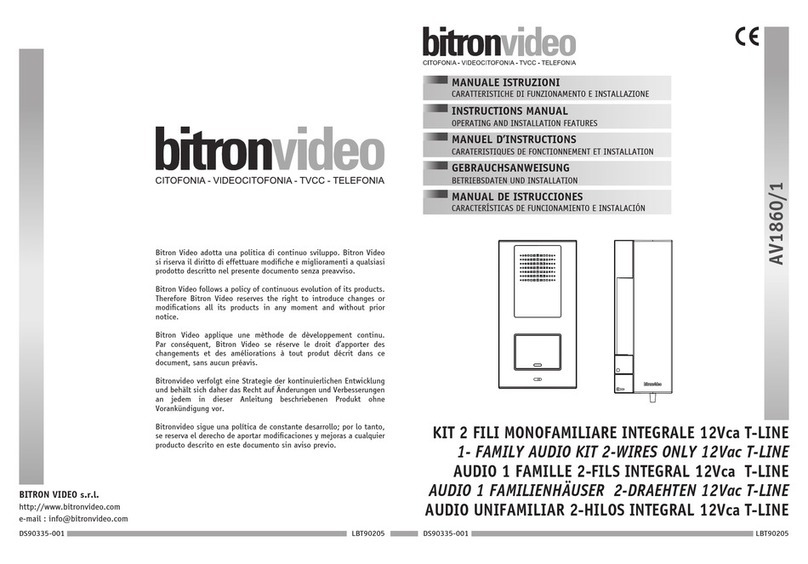
Bitron Video
Bitron Video AV1860/1 User manual
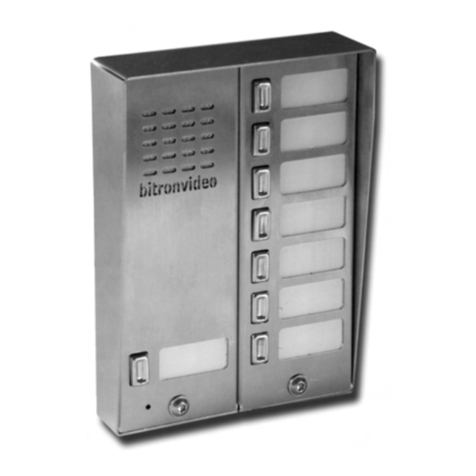
Bitron Video
Bitron Video AV1183 Series User manual

Bitron Video
Bitron Video AV1423/15 User manual
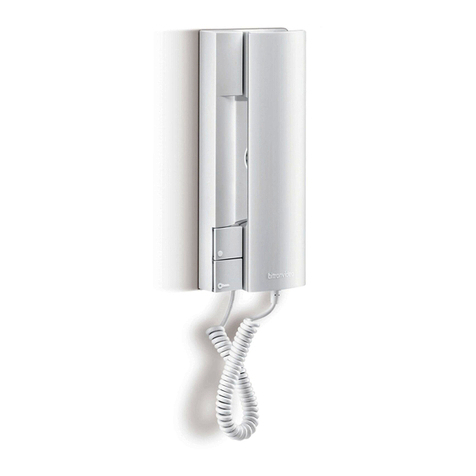
Bitron Video
Bitron Video AV1407/005 User manual

Bitron Video
Bitron Video ECHO 1 User manual
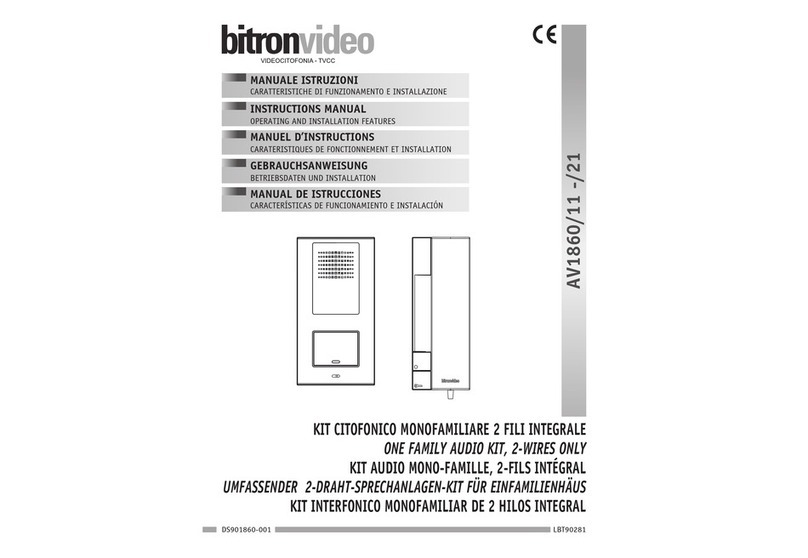
Bitron Video
Bitron Video AV1860/11 User manual

Bitron Video
Bitron Video AV2058/52 User manual
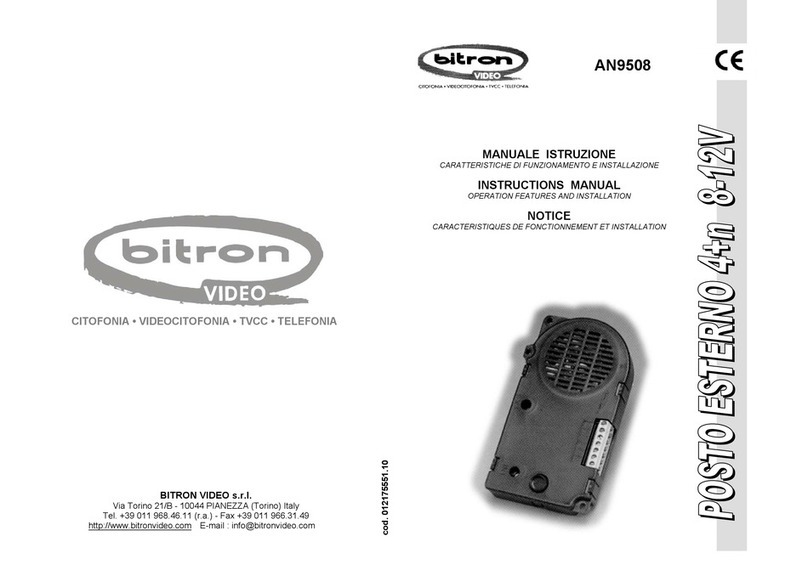
Bitron Video
Bitron Video AN9508 User manual
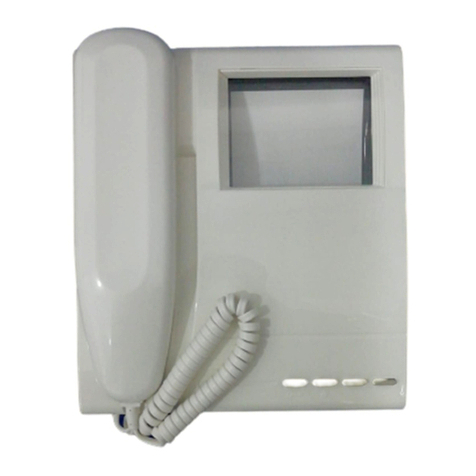
Bitron Video
Bitron Video MV1000 User manual

Bitron Video
Bitron Video GVM3000 User manual
